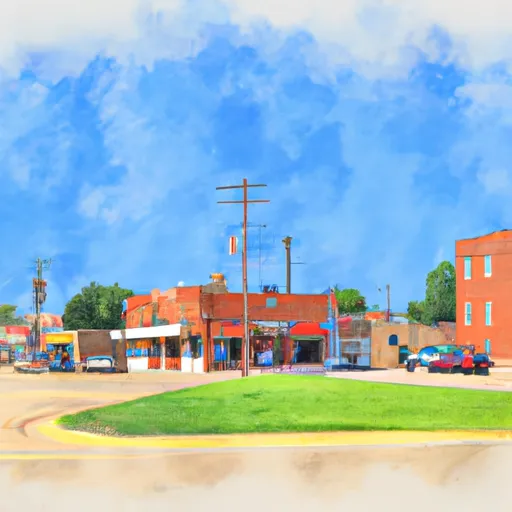-
 Snoflo Premium
Snoflo Premium
Get unlimited access to all our content
With no Ad interruptions! - Start Your Free Trial Login with existing account
Arcadia
Eden Index
Climate
8.3
•
Recreation
3.7
•
Community
•
Safeguard
4.6/10

Arcadia, Oklahoma has a humid subtropical climate with hot summers and mild winters. The town is situated near the Deep Fork River and other small streams, which contribute to the hydrology constituents of the area. Outdoor recreation opportunities in Arcadia include hiking and biking along the Deep Fork Trail and exploring the Arcadia Lake area. The lake offers activities such as fishing, boating, camping, and picnicking. Visitors can also enjoy a round of golf at the nearby Edmond Golf Course or take a scenic drive along historic Route 66. Overall, Arcadia provides a mix of outdoor activities and opportunities for relaxation in a beautiful natural setting.
What is the Eden Index?
The Snoflo Eden Index serves as a comprehensive rating system for regions, evaluating their desirability through a holistic assessment of climate health, outdoor recreation opportunities, and natural disaster risk, acknowledging the profound impact of these factors on livability and well-being.
Climate Health Indicator (CHI): 8.3
Arcadia receives approximately
885mm of rain per year,
with humidity levels near 80%
and air temperatures averaging around
16°C.
Arcadia has a plant hardyness factor of
7, meaning
plants and agriculture in this region tend to thrive during the non-winter months.
By considering the ideal temperature range, reliable water supplies, clean air, and stable seasonal rain or snowpacks, the Climate Health Indicator (CHI) underscores the significance of a healthy climate as the foundation for quality living.
A healthy climate is paramount for ensuring a high quality of life and livability in a region, fostering both physical well-being and environmental harmony. This can be characterized by ideal temperatures, reliable access to water supplies, clean air, and consistent seasonal rain or snowpacks.
Weather Forecast
Streamflow Conditions
Lower North Canadian
Area Rivers
Lower North Canadian
Snowpack Depths
Lower North Canadian
Reservoir Storage Capacity
Lower North Canadian
Groundwater Levels
Recreational Opportunity Index (ROI): 3.7
The Recreational Opportunity Index (ROI) recognizes the value of outdoor recreational options, such as parks, hiking trails, camping sites, and fishing spots, while acknowledging that climate plays a pivotal role in ensuring the comfort and consistency of these experiences.
Access to outdoor recreational opportunities, encompassing activities such as parks, hiking, camping, and fishing, is crucial for overall well-being, and the climate plays a pivotal role in enabling and enhancing these experiences, ensuring that individuals can engage in nature-based activities comfortably and consistently.
Camping Areas
| Campground | Campsites | Reservations | Toilets | Showers | Elevation |
|---|---|---|---|---|---|
| Wes Watkins Reservoir | 62 | 1,113 ft | |||
| Lake Thunderbird State Park - North | None | 1,081 ft | |||
| Pauls Valley City Lake | 28 | 910 ft | |||
| Mountain Lake | None | 1,002 ft | |||
| Healdton Municipal Lake | 57 | 900 ft | |||
| Chandler City Park - Purcell | 25 | 1,091 ft | |||
| Turner Falls Park | 500 | 960 ft | |||
| Dukes - Lake Murray State Park | None | 803 ft | |||
| Tinker AFB Military | None | 1,253 ft | |||
| Lake Thunderbird State Park - South | None | 1,146 ft |
Catastrophe Safeguard Index (CSI):
The Catastrophe Safeguard Index (CSI) recognizes that natural disaster risk, encompassing floods, fires, hurricanes, and tornadoes, can drastically affect safety and the overall appeal of an area.
The level of natural disaster risk in a region significantly affects safety and the overall livability, with climate change amplifying these risks by potentially increasing the frequency and intensity of events like floods, fires, hurricanes, and tornadoes, thereby posing substantial challenges to community resilience and well-being.
Community Resilience Indicator (CRI):
The Community Resilience Indicator (CRI) recognizes that education, healthcare, and socioeconomics are crucial to the well-being of a region. The CRI acknowledges the profound impact of these elements on residents' overall quality of life. By evaluating educational resources, healthcare accessibility, and economic inclusivity, the index captures the essential aspects that contribute to a thriving community, fostering resident satisfaction, equity, and social cohesion.

